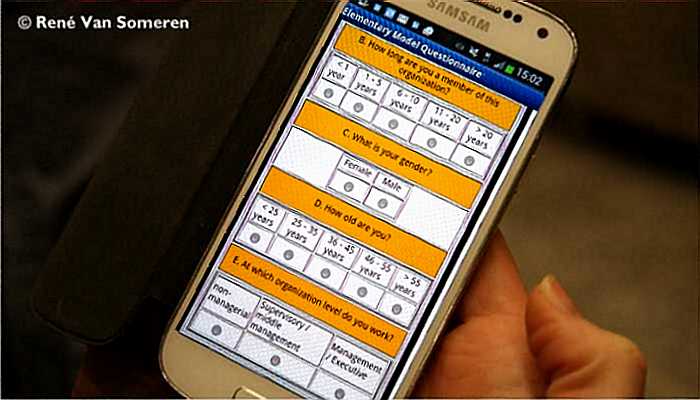 René Van Someren René Van Someren
The Elementary Model Questionnaire: Quantifying Organisational Behaviour.
Posted May 9, 2017
Related Publications:
- Thought to Behaviour (TtB): An integrative explanation of human behaviour, ISBN/EAN: 9789079641116
- Fundamentals of Organisations, ISBN/EAN: 9789079641109
- Aptitude and Attitude as Constraints and Enablers in Organisation Development: An Elementary Model of Organisational Processes, The Hague, Van Someren, ISBN/EAN: 9789079641086
Related Postings: See René Van Someren's Blog
The Elementary Model Questionnaire (EMQ) is designed to quantify organisation behaviour.
EMQ is based on principles of the Elementary Model of Organisational Processes (EMOP),
combined with the Theory of Thought to Behaviour (TtB).

The following illustrates an EMQ application:
Jane is CEO of an organisation that employs about 5,000
people. Some time ago, the board of directors’ grumbling reflected
shareholders’ sentiments about recent organisational developments and results.
Employees also showed signs of discontent. They were not outspoken about this,
but there was a sharp rise in sick leave and more employees than ever were
leaving the organisation. When walking through the premises, Jane saw very few
happy faces.
Jane and her team had all the figures with regard to
sales, revenues, production, employee retention, and so on. Still, they could
not find a univocal answer to the question: “What is going on?” In fact, many
of them insisted that there was nothing out of the ordinary within the
organisation.
Jane commissioned an independent general examination of the
organisation. A ‘check up’, so to speak. The researchers worked swiftly and
without raising a great commotion. Their examination had both quantitative and
qualitative elements. They used the Elementary Model Questionnaire (EMQ) to
translate various organisational behaviour aspects into numbers; they examined
various documents and interviewed several organisation members.
Less than one month after having started their examination,
the researchers reported their findings to Jane and her team. Those findings opened
Jane and her team’s eyes to certain organisational matters that they had not
been aware of, but also forced them to acknowledge the organisational impact of
certain matters that they had tended to deny or trivialise. To some degree,
management had misplaced its focus, giving too much care and attention to
certain organisational aspects, while tending too little to issues that did need their
attention. The examination brought various other things to light, such as
matters related to the organisational design, and to human resource management.
At Jane's request, the researchers consulted her and her team on tackling the discovered issues. Some time after those
organisational interventions had taken place, the researchers re-examined the
organisation, before presenting Jane and her team the qualitative and
quantitative data, comparing the current organisational situation with the previous one.
This data corresponded to more positive feedback that Jane had already
received from the board of directors and from within the organisation. It
seemed that they were now back on the right track.
EMQ allows collection of data from organisation members about (their attitudes towards) main organisational aspects.
Data are collected at three different organisational levels:
- Operational
- Supervisory / Middle Management
- Managerial / Executive
EMQ can be utilised to study organisational behaviour at
- Macro level, by querying an entire organisation;
- Meso level, by means of workgroup, organisational unit, etc.;
- Micro level, by inferring attitudes of (anonymous) individual organisation members.
Centralised processing of all official EMQ data, collected by registered EMOP consultants, also allows comparing new EMQ results to EMOP-indexes, made out from earlier collected EMQ data.
EMQ is an Internet application, as a result of which
respondents can participate at their convenience, at any time and at any place
in the world where they have Internet access. On average, filling in the entire
questionnaire takes about 5 minutes.
The basic EMQ can be extended, depending on a specific
information need or requirements that an organisation might have.
The numerical data that EMQ yields have more informational
value when placed in context by qualitative data. Such data could be collected, for instance, by
taking interviews and document analysis.
Dr. René Van Someren is an independent researcher, consultant, educator and author.
His personal website is: www.rene.vansomeren.org
René Van Someren's blog
|